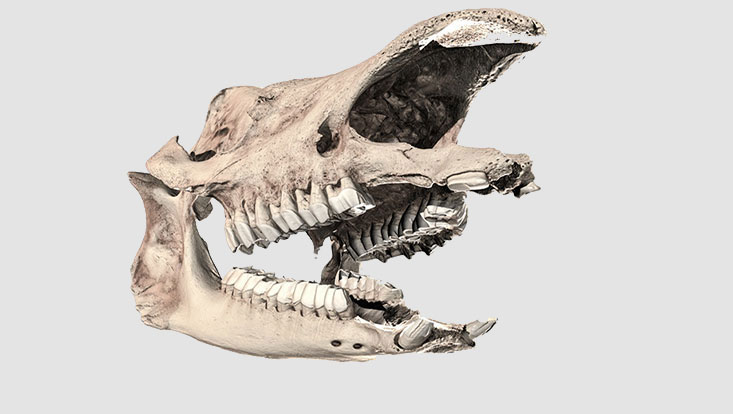
Artifact and collectibleTreasure of the month November: The skull of a Sumatran rhinoceros as knowledge archive
1 November 2017

Photo: Rendering, Volume Graphics
The exhibition "Vanishing Legacies: The World as Forest" combines contemporary art with historical documents and selected collection objects from tropical regions. The collection piece of a Sumatran rhinoceros skull from the LIB exemplifies an image of nature in the tension between scientific knowledge and medial de-naturalization. As an animated, colored CT scan, the skull serves science and at the same time draws attention to the situation of this species threatened with extinction as a visualized, alienated object.
Poached in the 1920s, the specimen was initially displayed as a trophy in a barracks. A naturalien dealer recognized the scientific value of the object during a clear-out and sold it to the Museum of Nature Hamburg - Zoology, where it is used scientifically as an important natural and cultural asset and has now been stylized as an artifact.
The Sumatran rhinoceros is one of the mammals of the tropics in Southeast Asia that is particularly endangered by poaching; currently, no more than 150 living animals are counted. The habitat is shrinking, the food basis is dwindling. Poachers mercilessly pursue the archaic colossus. The question of how this rhino species can be saved from extinction after all is also occupying the scientific community. "We need to know more about these animals in order to protect them and possibly offer them an alternative habitat," says Prof. Dr. Thomas Kaiser, head of mammalogy and paleoanthropology at LIB.
The animals live deep in the forests, and observing them is a difficult undertaking. To find out how and if the rhinos can survive in a new environment, knowledge about feeding strategies is important. Mammal specialist Kaiser measures tooth wear with surface parameters from the automotive industry, allowing him to match historical collection items with current laboratory experiments. The unchewed tooth structure of the Sumatran rhinoceros also reveals much about the species' dietary strategy.
On the occasion of Vanishing Legacies: The World as a Forest, Hamburg-based YXLON International, a manufacturer of industrial X-ray and computed tomography systems, enabled a high-resolution CT scan of the object for this purpose. A functional analysis of the masticatory apparatus can now be performed on it with the help of VGSTUDIO MAX, the analysis and visualization software from Volume Graphics.
"What is the basis of my work has now been further developed artistically by the curators of the exhibition Anna-Sophie Springer and Dr. Etienne Turpin," Kaiser said. "In doing so, they ultimately also support our cause: they draw the public's interest to the difficult task we face if we still want to succeed in preventing the extinction of these magnificent animals."
